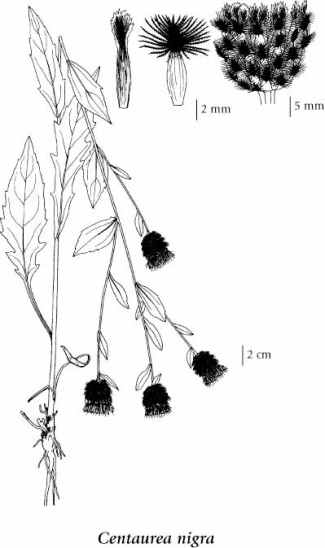Centaurea nigra L.
black knapweed (lesser knapweed)
Asteraceae (Aster family)
Introduction to Vascular Plants
black knapweed (lesser knapweed)
Asteraceae (Aster family)
Introduction to Vascular Plants
Species Information
General:
Perennial herb from a taproot; stems erect, branched, rough-hairy, 10-80 cm tall.
Leaves:
Basal leaves oblanceolate, long-stalked, toothed or shallowly lobed to entire, long-hairy above and below, the blade up to 15 cm long and 3 cm wide; stem leaves reduced and becoming unstalked upward.
Flowers:
Heads discoid, few to several, solitary at the ends of erect branches; disk flowers rose to purple, rarely white, the marginal ones not enlarged; involucres 12-15 mm tall, nearly as wide; involucral bracts with enlarged, broad, rounded, comb-like to tattered, black to dark brown appendages at the tips, these wider than the bracts.
Fruits:
Achenes compressed, light brown or light grey, sparsely hairy, 3-3.5 mm long; pappus in several series, about 1 mm long, rarely lacking.
Illustration

If more than one illustration is available for a species (e.g., separate illustrations were provided for two subspecies) then links to the separate images will be provided below. Note that individual subspecies or varietal illustrations are not always available.
Illustration Source: The Illustrated Flora of British Columbia
Habitat and Range
Mesic to dry roadsides and fields in the lowland and montane zones; rare in S BC south of 51degreeN; introduced from Europe.Status Information
Synonyms
Synonyms and Alternate Names:
Centaurea nigra var. radiata DC.